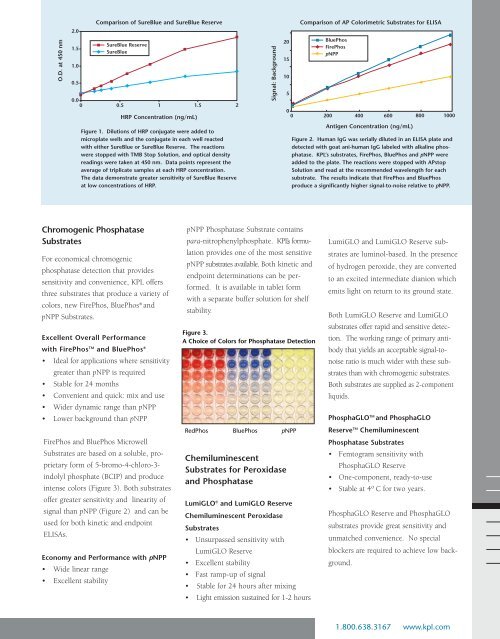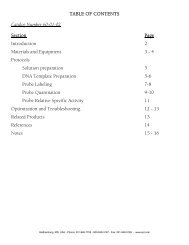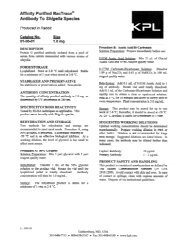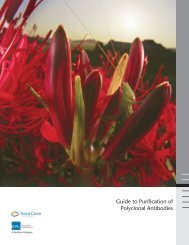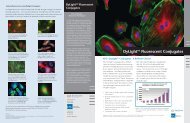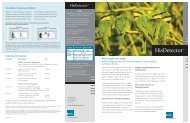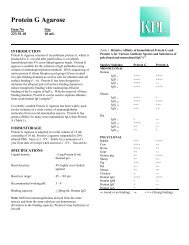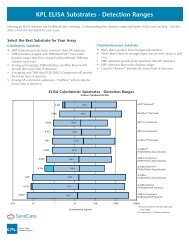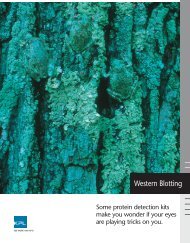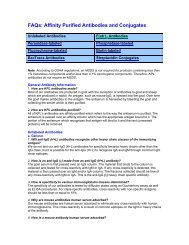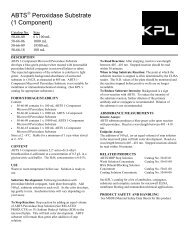KPL ELISA Brochure
KPL ELISA Brochure
KPL ELISA Brochure
Create successful ePaper yourself
Turn your PDF publications into a flip-book with our unique Google optimized e-Paper software.
Comparison of SureBlue and SureBlue ReserveComparison of AP Colorimetric Substrates for <strong>ELISA</strong>2.0O.D. at 450 nm1.51.00.5SureBlue ReserveSureBlue0.00 0.5 1 1.5 2Signal: Background2015105BluePhosFirePhospNPPHRP Concentration (ng/mL)Figure 1. Dilutions of HRP conjugate were added tomicroplate wells and the conjugate in each well reactedwith either SureBlue or SureBlue Reserve. The reactionswere stopped with TMB Stop Solution, and optical densityreadings were taken at 450 nm. Data points represent theaverage of triplicate samples at each HRP concentration.The data demonstrate greater sensitivity of SureBlue Reserveat low concentrations of HRP.00 200 400 600 800 1000Antigen Concentration (ng/mL)Figure 2. Human IgG was serially diluted in an <strong>ELISA</strong> plate anddetected with goat ani-human IgG labeled with alkaline phosphatase.<strong>KPL</strong>’s substrates, FirePhos, BluePhos and pNPP wereadded to the plate. The reactions were stopped with APstopSolution and read at the recommended wavelength for eachsubstrate. The results indicate that FirePhos and BluePhosproduce a significantly higher signal-to-noise relative to pNPP.Chromogenic PhosphataseSubstratesFor economical chromogenicphosphatase detection that providessensitivity and convenience, <strong>KPL</strong> offersthree substrates that produce a variety ofcolors, new FirePhos, BluePhos ® andpNPP Substrates.Excellent Overall Performancewith FirePhos TM and BluePhos ®• Ideal for applications where sensitivitygreater than pNPP is required• Stable for 24 months• Convenient and quick: mix and use• Wider dynamic range than pNPP• Lower background than pNPPFirePhos and BluePhos MicrowellSubstrates are based on a soluble, proprietaryform of 5-bromo-4-chloro-3-indolyl phosphate (BCIP) and produceintense colors (Figure 3). Both substratesoffer greater sensitivity and linearity ofsignal than pNPP (Figure 2) and can beused for both kinetic and endpoint<strong>ELISA</strong>s.Economy and Performance with pNPP• Wide linear range• Excellent stabilitypNPP Phosphatase Substrate containspara-nitrophenylphosphate. <strong>KPL</strong>’s formulationprovides one of the most sensitivepNPP substrates available. Both kinetic andendpoint determinations can be performed.It is available in tablet formwith a separate buffer solution for shelfstability.Figure 3.A Choice of Colors for Phosphatase DetectionRedPhos BluePhos pNPPChemiluminescentSubstrates for Peroxidaseand PhosphataseLumiGLO ® and LumiGLO ReserveChemiluminescent PeroxidaseSubstrates• Unsurpassed sensitivity withLumiGLO Reserve• Excellent stability• Fast ramp-up of signal• Stable for 24 hours after mixing• Light emission sustained for 1-2 hoursLumiGLO and LumiGLO Reserve substratesare luminol-based. In the presenceof hydrogen peroxide, they are convertedto an excited intermediate dianion whichemits light on return to its ground state.Both LumiGLO Reserve and LumiGLOsubstrates offer rapid and sensitive detection.The working range of primary antibodythat yields an acceptable signal-tonoiseratio is much wider with these substratesthan with chromogenic substrates.Both substrates are supplied as 2-componentliquids.PhosphaGLO TM and PhosphaGLOReserve TM ChemiluminescentPhosphatase Substrates• Femtogram sensitivity withPhosphaGLO Reserve• One-component, ready-to-use• Stable at 4 o C for two years.PhosphaGLO Reserve and PhosphaGLOsubstrates provide great sensitivity andunmatched convenience. No specialblockers are required to achieve low background.1.800.638.3167 www.kpl.com


